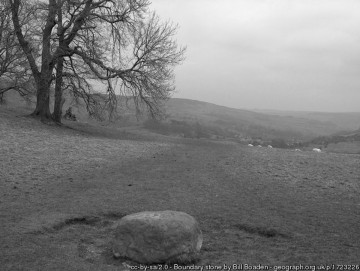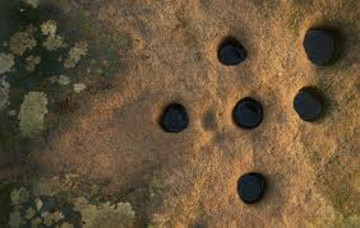The Boundary Stone

The Boundary Stone acted as a marker separating the residents of the plague affected village of Eyam from the non-affected villagers of Stoney Middleton in 1665. It is here during the plague that money soaked in vinegar (believed to kill the infection) was placed by the villagers of Eyam in exchange for food and medical supplies.
The Great Plague Eyam 1665
The village of Eyam has become popularly known as the Plague Village, a fact that has made it one of the most visited and well know village’s in the Peak District, for it has a fascinating yet tragic story to tell. In August 1665 the bubonic plague arrived at the house of the village tailor George Viccars, via a parcel of cloth from London. The cloth was damp and was hung out in front of the fire to dry, releasing the plague infested fleas, claiming George as the first plague victim who died of a raging fever on 7th September 1665.
The Boundary Stone
As the plague took hold and decimated the villagers it was the selfless decision to quarantine themselves that prevented the spread the disease and it is

here that their closest neighbour, Stoney Middleton, just a short stroll across an open field joins the story. To minimize cross infection, food and other supplies were left at the Boundary Stone which was situated midway between the villages. The stone had 6 holes drilled into its surface where money left as payment was left in vinegar soaked holes, believed to kill the infection.
Gratitude to the sacrifice
The Plague in Eyam raged for 14 months and claimed the lives of at least 260 villagers. By 1st November 1666 it had run its course and claimed its last victim. Eyam’s selfless villagers, with their strong Christian convictions, had shown immense personal courage and self-sacrifice. They had prevented the plague from spreading to other parishes, but many paid the ultimate price for their commitment. Almost 350 years later a remembrance service is still held every Plague Sunday at Cucklett Delf, on the edge of the village.
Emmott Sydall and Rowland Torre a sad tale of a lost love
Cucklett Delf also represents a story of heartbreak concerning Emmott Sydall and Rowland Torre. Emmott was a young girl of about twenty two who was betrothed to Rowland Torre from Stoney Middleton. Emmott lived in a cottage across from Mary Cooper’s house where the Plague started. Her father John Syddall and four of her siblings were among the first victims of the disease. At first Rowland would visit Emmott in the village, but when they realised this was too dangerous, the lovers would arrange to meet secretly but at a distance minimalizing any risk of Rowland catching the disease. It is suggested that the two would only have looked at each other from a distance, and in silence, lest their plan should be discovered.
When Emmott stopped appearing towards the end of April 1666, Rowland continued to go to their meeting place, with hope that against all odds, she might still show up. He was one of the first people to re-enter the village when it was pronounced safe towards the end of 1666, but was soon told the worst; Emmott Syddall had died in the April.
It was coollllllllllllllll!!!!!!!!
How apt this story is. It makes me so proud to be from Derbyshire. Tomorrow I shall visit the plague stone and my wife will be on the other side of it. She is an NHS worker in Manchester and I am in Derby protecting my elderly parents. We can’t get near to each other for many months at the very least. Nothing compared to the ultimate sacrifice of the people of Eyam. Their actions makes me feel stronger and I sincerely hope it makes you feel a little better aswell. Stay strong people. Try a smile. Go on.
Hi Guybongo, I am a journalist at The New York Times and I would love to hear more about your family’s story and potentially write about it, would you be willing to send me an email? lauren.jackson@nytimes.com
Having just finished reading Simon Armitage’s poem ‘Lockdown I wanted to find our more about Eyam and the Boundary Stone. Very moving and defining did I find this story of humility, discipline and strength of character. Perhaps we all need to reflect on stories of our heritage where our kinfolk and others survived great hardship with sacrifice. But let’s all be positive in our days ahead. Let’s help ourselves to be sensible and stay healthy and in doing so let us not forget others who may be struggling and need a smile and perhaps a virtual helping hand.
Be strong – be positive.
Thank you for this information.
My husband, who has walked in your area, told me about the stone and I am wondering if the belief that vinegar would kill infection could apply today.
Whether or not this is applicable to Covid-19 remains to be proven but I shall be soaking my change from now on before reusing it.
Very best wishes.
I visited Eyam many years ago as a young man. When you are young and healthy there are no limits on your ability to endure hardship. Now I am past middle age with an underlying health condition living in Eastern Europe where testing is mainly absent. Along with my wife and two young children, we have taken shelter at our remote family cottage and are in the process of growing fruit and vegetables in our large garden, due to the fact that we have duly been informed there may be shortages in fresh produce in the coming months. I am a native of Manchester and still possess some of that British spirit that we will not be beaten by this unseen menace. Having seen in the aftermath of events in Eyam how people were consumed by another menace, they still maintained their dignity in defying this terribly overwhelming veil of darkness to offer help to each other when all seemed beyond hope. This will be my inspiration when the darkness of despair finally envelopes us here in this corner of Europe. That we will overcome it with equal measures of altruism and kindness, lest we perish. This unseen foe cannot take our love for each other away. We will endure.
I am an older person in the United States, but I am a descendant of survivors of the Eyam plague. I take inspiration from them as I isolate and encourage others to do the same. They did not know exactly how the plague spread, but had a good enough idea that, with encouragement from their local minister, they isolated themselves to try to protect others in Derbyshire. Strong people.